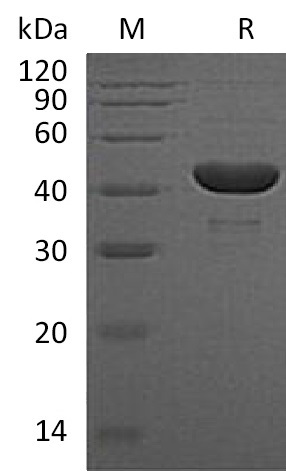- Remove All
 Your shopping cart is currently empty
Your shopping cart is currently empty
Shopping Cart
PGK1 Protein, Human, Recombinant (His)
Catalog No. TMPJ-00727
Phosphoglycerate kinase 1(PGK1) is an enzyme. It is mainly expressed in spermatogonia and Localized on the principle piece in the sperm. Its expression significantly decreased in the testis of elderly men. PGK1 involved in a critical energy-producing process known as glycolysis. It helps carry out a chemical reaction that converts a molecule called 1,3-diphosphoglycerate, which is produced during the breakdown of glucose, to another molecule called 3-phosphoglycerate during glycolysis. PGK1 may also act as a cofactor for polymerase alpha. The protein has been identified as a moonlighting protein based on its ability to perform mechanistically distinct functions.

PGK1 Protein, Human, Recombinant (His)
Catalog No. TMPJ-00727
Phosphoglycerate kinase 1(PGK1) is an enzyme. It is mainly expressed in spermatogonia and Localized on the principle piece in the sperm. Its expression significantly decreased in the testis of elderly men. PGK1 involved in a critical energy-producing process known as glycolysis. It helps carry out a chemical reaction that converts a molecule called 1,3-diphosphoglycerate, which is produced during the breakdown of glucose, to another molecule called 3-phosphoglycerate during glycolysis. PGK1 may also act as a cofactor for polymerase alpha. The protein has been identified as a moonlighting protein based on its ability to perform mechanistically distinct functions.
| Pack Size | Price | Availability | Quantity |
|---|---|---|---|
| 10 μg | $184 | 7-10 days | |
| 50 μg | $545 | 7-10 days | |
| 500 μg | $1,900 | 7-10 days | |
| 1 mg | $2,970 | 7-10 days |
Bulk & Custom
Add to Cart
Select Batch
Resource Download
Product Information
| Biological Activity | Activity has not been tested. It is theoretically active, but we cannot guarantee it. If you require protein activity, we recommend choosing the eukaryotic expression version first. |
| Description | Phosphoglycerate kinase 1(PGK1) is an enzyme. It is mainly expressed in spermatogonia and Localized on the principle piece in the sperm. Its expression significantly decreased in the testis of elderly men. PGK1 involved in a critical energy-producing process known as glycolysis. It helps carry out a chemical reaction that converts a molecule called 1,3-diphosphoglycerate, which is produced during the breakdown of glucose, to another molecule called 3-phosphoglycerate during glycolysis. PGK1 may also act as a cofactor for polymerase alpha. The protein has been identified as a moonlighting protein based on its ability to perform mechanistically distinct functions. |
| Species | Human |
| Expression System | HEK293 Cells |
| Tag | C-6xHis |
| Accession Number | P00558 |
| Synonyms | Primer recognition protein 2,Phosphoglycerate kinase 1,PGKA,PGK1,Cell migration-inducing gene 10 protein |
| Amino Acid | Ser2-Ile417 |
| Construction | Ser2-Ile417 |
| Protein Purity | Greater than 95% as determined by reducing SDS-PAGE. (QC verified)  |
| Molecular Weight | 37-50 KDa (reducing condition) |
| Endotoxin | < 0.1 ng/µg (1 EU/µg) as determined by LAL test. |
| Formulation | Supplied as a 0.2 μm filtered solution of 20 mM Tris-HCl, 150 mM NaCl, 20% Glycerol, pH 8.0. |
| Stability & Storage | Lyophilized powders can be stably stored for over 12 months, while liquid products can be stored for 6-12 months at -80°C. For reconstituted protein solutions, the solution can be stored at -20°C to -80°C for at least 3 months. Please avoid multiple freeze-thaw cycles and store products in aliquots. |
| Shipping | Shipping with blue ice. |
| Research Background | Phosphoglycerate kinase 1(PGK1) is an enzyme. It is mainly expressed in spermatogonia and Localized on the principle piece in the sperm. Its expression significantly decreased in the testis of elderly men. PGK1 involved in a critical energy-producing process known as glycolysis. It helps carry out a chemical reaction that converts a molecule called 1,3-diphosphoglycerate, which is produced during the breakdown of glucose, to another molecule called 3-phosphoglycerate during glycolysis. PGK1 may also act as a cofactor for polymerase alpha. The protein has been identified as a moonlighting protein based on its ability to perform mechanistically distinct functions. |
Dose Conversion
You can also refer to dose conversion for different animals. More
Calculator
Tech Support
Please read the User Guide of Recombinant Proteins for more specific information.

Copyright © 2015-2025 TargetMol Chemicals Inc. All Rights Reserved.


